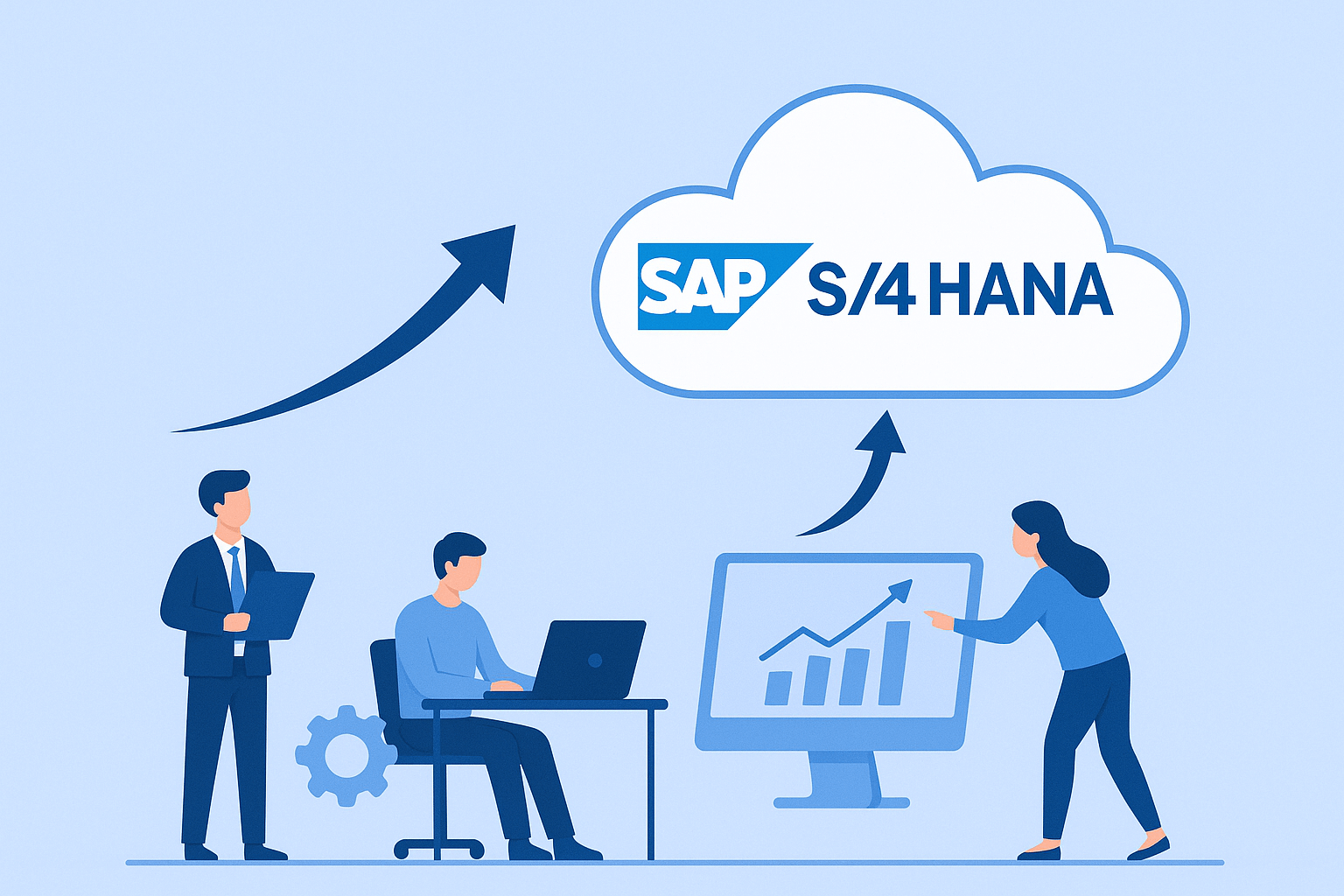“It’s easier to change a ship’s course than to replace its engine in the middle of the ocean.”
In your digital transformation journey, moving to SAP S/4HANA is like navigating your corporate ship toward a new harbor. But reaching that harbor safely requires more than just boosting engine power; it demands a clear assessment of the vessel’s condition, a well-defined route, and a fully prepared crew. SAP S/4HANA migration is not a simple technical upgrade—it is a comprehensive strategic transformation project that carries your business processes, data, and operational structure into the future. So, before setting sail on this ambitious voyage, which departments need to prepare, and how? This guide offers a practical roadmap to ensure every detail is checked before you raise the sails.
What Is S/4HANA Migration and Why Does It Matter?
SAP S/4HANA Migration is the process of moving an organization’s existing SAP ERP systems to SAP’s next-generation enterprise resource planning platform, S/4HANA. This transition is not merely a system upgrade; it represents a shift to a simplified, faster, mobile-ready, and data-driven infrastructure, powered by a streamlined data model. With the in-memory HANA database at its core, S/4HANA delivers unprecedented processing power, significantly improving performance and simplifying operations.
This transformation is not only a technical necessity—as SAP phases out support for legacy ERP systems on specific timelines—but also a strategic opportunity for companies seeking to modernize and align their processes with the digital era. However, success in this journey relies on more than technical readiness; it requires strong organizational preparation across all levels of the business.
Before Deciding on S/4HANA Migration: The Evaluation Phase
S/4HANA migration is far more than an IT decision—it is a board-level commitment that defines your organization’s vision for digital transformation. The first step is to thoroughly analyze the current state of your systems, business processes, customization levels, and data quality. Tools provided by SAP—such as Readiness Check, Custom Code Analyzer, and Business Scenario Recommendations—help assess the existing environment, identify risks, and uncover opportunities for process simplification.
Equally important is selecting the right migration approach: Greenfield (new implementation), Brownfield (system conversion), or Selective Data Transition (hybrid). This choice should be based not only on technical considerations but also on business process maturity, organizational change readiness, and budget/timeline constraints. Goals such as cleaning up legacy data or redesigning core business processes play a decisive role in choosing the right migration path.

The Migration Decision Is Made: What Should Each Team Do Next?
S/4HANA migration must be approached as a company-wide initiative and executed through close collaboration among different teams. Below are the key departments that play an active role in the transition, along with their responsibilities.
1. The Role and Responsibilities of SAP Basis Teams
At the heart of every S/4HANA migration lies the SAP Basis team, which forms the technical backbone of the project. If your company outsources SAP Basis services, the experience of the service provider will directly impact the success of the migration. The main responsibilities of SAP Basis teams include:
- System analysis and inventory: Evaluating the configuration, versions, and architecture of existing systems.
- Compatibility checks: Verifying SAP kernel, database, and operating system versions against SAP’s Product Availability Matrix (PAM).
- Migration strategy preparation: Configuring key tools such as SUM (Software Update Manager), DMO (Database Migration Option), and SAP Maintenance Planner. In a Brownfield scenario, DMO is among the most commonly used and technically reliable approaches for transitioning from a legacy database to HANA.
- Pre-migration technical readiness: Going beyond simply running an update wizard by ensuring comprehensive compatibility checks, performance tuning, and security validations.
- Environment setup: Preparing sandbox, test, and quality assurance systems.
- Database migration: Moving data to HANA if the current system runs on a non-HANA database.
- Performance testing: Running load tests to identify and resolve bottlenecks.
- Rollback planning: Defining fallback scenarios in case the migration encounters critical failures.
- Go-live technical support: Ensuring system stability and resolving issues during the production cutover.
These responsibilities require not only deep technical expertise but also strong project management and documentation discipline to ensure a smooth transition.
2. SAP Application Teams – Reviewing Business Processes
SAP functional consultants play a key role in evaluating each module’s current usage and contributing to the redesign of processes in the new environment. Their responsibilities include:
Analyzing the impact of new S/4HANA technologies on business units.
Comparing custom developments with SAP standard processes and identifying new standard functionalities available in S/4HANA.
Reviewing SAP Best Practice scenarios to align processes with global standards.
Testing user interfaces with SAP Fiori, which introduces a new role-based, task-driven user experience that can fundamentally reshape business workflows.
Validating system configuration (SPRO) to ensure compatibility with the new environment.
Revisiting integration scenarios with other systems and applications.
In addition to their functional role, application teams also serve as a bridge between business units and technical teams, ensuring alignment across the organization.

Further Reading

3. Business Units – Active Involvement of Process Owners
S/4HANA migration is not solely an IT project; it is a strategic transformation that requires business units to reassess their processes and needs.
Operational departments such as Finance, Logistics, Sales, and Human Resources are the true owners of the SAP-driven processes, making them some of the most critical stakeholders in this journey. Their responsibilities include:
Understanding the upcoming changes introduced by the new system.
Identifying opportunities to simplify manual steps in workflows.
Defining test cases and conducting user acceptance tests (UAT).
Outlining reporting requirements specific to the new system.
Designing temporary workflows to prevent operational disruptions during migration.
S/4HANA represents not just a technological shift but a transformation in the way the organization operates. That’s why the active participation of business units is essential for project success.
4. Data Governance Team – Preparing Clean and Compliant Data
Data quality is one of the most critical success factors in an S/4HANA migration. Key structural changes, such as the transition of customer and vendor data into the unified Business Partner (BP) model, make strong data governance even more vital.
Key responsibilities include:
Cleansing master data (customers, vendors, materials, general ledgers, etc.).
Detecting duplicates and ensuring standardization of records.
Defining data ownership within the organization.
Selecting the relevant datasets to be transferred during migration.
Testing data loading scenarios to validate accuracy and completeness.
The team must also be prepared to leverage data migration tools such as LSMW, SAP Data Services, and Migration Cockpit.
5. Project Management Office (PMO) – Ensuring Coordination and Control
Strong project management is essential to ensure that all preparations are executed on time, within scope, and on budget.
The PMO’s responsibilities include:
Project planning, resource allocation, and budget management.
Task assignment and responsibility tracking.
Risk and dependency management – identifying potential risks such as incompatible custom codes or delays in data cleansing, and creating mitigation plans in advance.
Facilitating communication through meetings, checklists, and progress reporting.
Driving change management and internal communication to align both technical and business stakeholders.
Ultimately, the PMO must possess the ability to orchestrate both technical and functional teams simultaneously, ensuring alignment and smooth execution across the organization.

6. Training and Change Management Teams – Driving User Adoption
With S/4HANA, user interfaces, screen layouts, and process flows undergo significant changes, making user adaptation a critical success factor.
Key responsibilities include:
Developing training content tailored to the new system.
Creating a training schedule and implementation plan.
Establishing user support mechanisms such as help desk, FAQs, and documentation.
Conducting awareness programs to minimize resistance to change.
It’s important to remember: even the most advanced system cannot succeed without strong user adoption.
7. Reporting and Analytics Teams – Designing the Future of Insights
S/4HANA introduces a transformed analytics landscape. Thanks to Embedded Analytics, organizations can analyze operational data in real time without relying on separate business intelligence systems.
Core tasks include:
Ensuring compatibility of existing reports.
Planning for new technologies such as SAP Fiori, CDS Views, and Embedded Analytics.
Validating integration with BW systems.
Defining use cases for SAP Analytics Cloud (SAC).
By involving analytics teams early, S/4HANA migration becomes not only an operational transformation but also an analytical revolution that elevates decision-making across the enterprise.
Common Misconceptions About S/4HANA Migration
Relying on myths or hearsay when planning your S/4HANA migration can jeopardize the entire project. Here are some of the most common misconceptions – and the realities behind them:
“Migration is just an IT project.”
In reality, it requires a multi-disciplinary effort spanning IT, business units, and data governance.
“We can transfer all data as-is.”
Without data cleansing, migrated records will cause performance issues and reporting inaccuracies in the new system.
“All custom codes can be reused.”
S/4HANA’s simplified architecture is often incompatible with legacy custom developments. Careful analysis and restructuring are essential.
“Brownfield migration is always less risky.”
In systems with significant technical debt, Brownfield may trigger unexpected compatibility issues.
“HANA makes everything faster.”
While HANA’s in-memory design is powerful, unoptimized queries and outdated reports will still underperform. Leveraging new approaches like CDS Views and AMDP is mandatory.
“Fiori is just a new interface.”
Fiori is more than a UI; it’s about role-based access and process redesign. For users accustomed to classic SAP GUI transactions, adaptation planning is crucial.
“A technical migration is enough.”
Without training, user adoption, and change management, even the most advanced system will fail to deliver value.
“Everything ends after go-live.”
Go-live is only the beginning of transformation. Stabilization, ongoing support, and continuous optimization must also be part of the roadmap.

What Happens If S/4HANA Migration Preparations Are Inadequate? Potential Risks
Migrating to S/4HANA requires thorough planning and seamless coordination. If preparations are incomplete or superficial, organizations may face serious risks such as:
Data loss: Missing or faulty data transformation can disrupt business operations.
System crashes in production: Inadequate testing or incompatible components can render the system unusable. Custom codes, in particular, represent a significant risk and must be thoroughly analyzed before migration.
User resistance: Without proper training, users may struggle to adapt to new interfaces, leading to low adoption rates.
Migration delays: Poor planning can extend timelines, resulting in project overruns and budget issues.
Process disruptions: Critical workflows may fail post-migration, directly impacting customer satisfaction.
To prevent these risks, it is crucial that every team fulfills its responsibilities accurately and on time.
Conclusion: S/4HANA Migration Is Not Just a Technology Project, but an Enterprise Transformation
S/4HANA migration is far more than a technical upgrade—it is a strategic initiative that redefines business processes and accelerates digital transformation goals. The success of this journey depends on the collaborative involvement of both technical and functional teams, led by SAP Basis as the backbone of the transition.
If your organization is preparing for S/4HANA migration, take every step carefully and engage experienced experts. Partnering with a trusted provider specialized in SAP Basis services minimizes technical risks and ensures a smooth, efficient transition.
With the right strategy and expert guidance, your business can unlock the full potential of S/4HANA. Contact us today to start your seamless migration journey.

